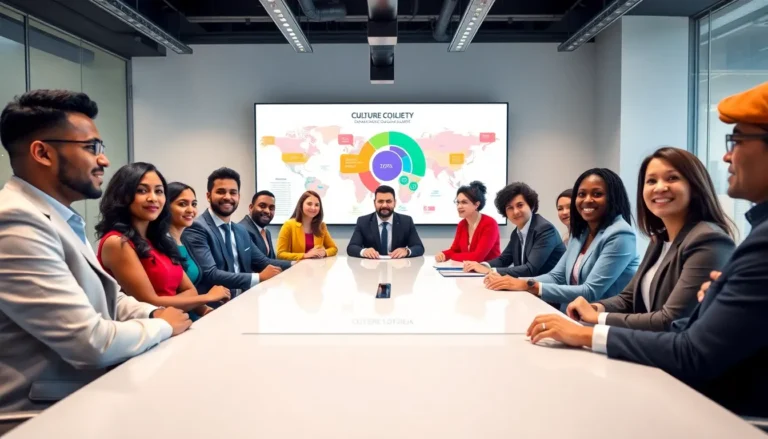In a world where the only constant is change, next-level leadership is the secret sauce that transforms good teams into great ones. It’s not just about barking orders from a corner office or sending out endless emails. Nope, it’s about inspiring and empowering others to embrace challenges with a smile—preferably while wearing their favorite superhero cape.
Imagine a leader who not only knows the way but also shows the way, all while keeping the atmosphere light and engaging. This isn’t just a fantasy; it’s a necessity in today’s fast-paced environment. Next-level leaders don’t just adapt; they thrive, turning obstacles into opportunities and making work feel less like a chore and more like an adventure. Buckle up as we dive into the traits and strategies that define these extraordinary leaders.
Table of Contents
ToggleUnderstanding Next-Level Leadership
Next-level leadership transforms good teams into exceptional ones. It focuses on inspiring, empowering, and engaging team members to tackle challenges effectively.
Definition and Importance
Next-level leadership represents a shift from traditional leadership models. This approach emphasizes collaboration instead of mere direction. Leaders skilled in this style cultivate innovation and adaptability within their organizations. They create an environment where initiative thrives, versus stifling creativity. Each team member realizes their potential, contributing to the team’s overall success. This leadership style is crucial for navigating today’s fast-paced business landscape.
Key Characteristics of Next-Level Leaders
Next-level leaders exhibit discernible traits that set them apart. These individuals show outstanding communication skills, fostering open dialogue among team members. They demonstrate empathy, understanding team dynamics and individual challenges. Flexibility characterizes their decision-making, allowing them to adjust strategies quickly. Vision is another key trait; these leaders inspire others by sharing a compelling future outlook. Accountability remains essential; they take ownership of both successes and failures, understanding that growth stems from learning.
Strategies for Developing Next-Level Leadership Skills

Next-level leadership requires a combination of emotional intelligence and effective communication techniques. Focusing on these areas significantly enhances a leader’s ability to inspire and empower teams.
Emotional Intelligence in Leadership
Emotional intelligence plays a crucial role in next-level leadership. Leaders with high emotional intelligence recognize their own emotions and those of their team. Understanding these emotions fosters empathy, which builds trust within the team. Recognizing when team members face difficulties allows leaders to provide support and guidance effectively. Moreover, managing emotions during challenging situations influences team dynamics positively. Encouraging open discussions about feelings creates a safe environment for collaboration. Thus, emotional intelligence becomes essential for leaders aiming to elevate their teams.
Effective Communication Techniques
Effective communication techniques strengthen team cohesion and clarity. Leaders should prioritize active listening to understand team members’ perspectives fully. Clarity in articulating goals and expectations minimizes confusion and aligns efforts. Using positive language motivates and inspires teams toward achieving their objectives. Providing constructive feedback fosters growth and learning, essential for team development. Regular check-ins facilitate ongoing dialogue, helping leaders remain connected with their teams. Consistent communication builds transparency and trust, crucial elements in next-level leadership.
The Role of Vision in Next-Level Leadership
Vision plays a critical role in shaping next-level leadership. A compelling vision not only inspires but also guides teams toward common goals.
Creating a Compelling Vision
Creating a compelling vision requires clarity and foresight. Leaders focus on articulating a future that resonates with their team’s values and aspirations. Clear goals help team members understand the purpose behind their work. Specificity about the desired outcomes fosters engagement and motivation. For example, leaders in innovative companies often outline ambitious objectives that encourage team members to think creatively and embrace new ideas. Regularly revisiting the vision reinforces its importance, keeping it at the forefront of team discussions.
Aligning Teams with Vision
Aligning teams with a vision ensures everyone works toward shared objectives. Effective leaders communicate the vision consistently across all levels of the organization. Strategies like team workshops allow individuals to voice ideas and contribute to the vision. By incorporating feedback, leaders personalize the vision, making it more relatable for team members. Collaboration strengthens the connection between team tasks and the overarching goals. Frequent progress updates help maintain focus and accountability, ensuring teams feel aligned and motivated to achieve the vision together.
Challenges Faced by Next-Level Leaders
Next-level leaders encounter various challenges that test their effectiveness. Overcoming these hurdles requires strategic approaches and unwavering commitment.
Overcoming Resistance to Change
Resistance to change often hampers progress in organizations. Leaders recognize that some team members cling to established routines and practices. Addressing this resistance involves engaging individuals through clear communication, presenting data that supports the need for change, and highlighting the benefits. Building trust is crucial; when team members feel valued and informed, their willingness to adapt increases. Utilizing feedback loops allows leaders to gauge concerns and adjust strategies, fostering a culture of collaboration during transitions.
Navigating Organizational Politics
Leaders must navigate complex organizational politics to drive initiatives forward. Understanding power dynamics helps them effectively influence stakeholders, ensuring alignment with strategic goals. Building relationships with key decision-makers is essential for securing buy-in. Proactive listening and fostering open dialogues create a transparent environment where differing viewpoints can be expressed. Leaders trained in diplomacy leverage these skills to turn potential conflicts into opportunities for collaboration. Balancing various interests while maintaining focus on the overall vision becomes pivotal for their success.
Next-level leadership is essential for building high-performing teams that can adapt and thrive in a dynamic environment. By prioritizing collaboration and fostering a culture of innovation leaders can transform challenges into opportunities. The emphasis on emotional intelligence and effective communication creates an atmosphere of trust and engagement that empowers team members.
A clear and compelling vision serves as a guiding light for teams ensuring alignment and motivation. As leaders navigate the complexities of organizational dynamics they must remain flexible and diplomatic to maintain focus on their objectives. Embracing these principles not only enhances leadership effectiveness but also drives sustainable success in today’s fast-paced business landscape.








